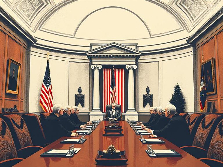
The Secret Sauce of Government: Demystifying the Mighty Memorandum to Cabinet
Memorandum to Cabinet: The Engine Room of Government Decision-Making
Let’s be honest, “Memorandum to Cabinet” sounds like the title of a dusty government manual you’d find buried in an archive. But step into my world for a moment. After years navigating the intricate dance of policy and politics, I can tell you this: the humble MC is arguably the most critical document you’ve never heard of. It’s not just paperwork; it’s the lifeblood of how major government decisions are conceived, debated, and ultimately born. Forget the public speeches and press releases for a second; the real story often starts and ends with an MC.
Think of it as the ultimate proposal, but instead of pitching a new marketing campaign, you’re pitching a multi-billion dollar policy shift, a new law, or a fundamental change in how the government operates. The audience? The most powerful elected officials in the land: the Cabinet Ministers. Getting an MC right isn’t just about good writing; it’s about strategy, persuasion, rigorous analysis, and navigating a complex web of rules and relationships. It’s where the rubber meets the road in governance.
In this deep dive, we’ll peel back the curtain. We’ll explore exactly what a Memorandum to Cabinet is, why it holds such immense power, the intricate process of crafting and shepherding one through the system, and the real-world consequences when it lands (or doesn’t) on the Cabinet table. Whether you’re a budding policy analyst, a business leader needing to understand government drivers, or just a curious citizen, understanding the MC is key to understanding how power truly works. Buckle up.
What Exactly Is a Memorandum to Cabinet? Breaking Down the Basics
At its core, a Memorandum to Cabinet (MC) is a formal written submission prepared by a government department or ministry, addressed directly to the Cabinet. Its primary purpose? To seek a decision from Cabinet Ministers on a significant policy proposal, legislative initiative, major expenditure, or other critical government matter. It’s not just an FYI; it’s a clear “Here’s the issue, here’s what we think we should do, and we need you (Cabinet) to say ‘yes’.”
Imagine you’re the Minister of Health. Your department identifies a pressing need to overhaul mental health services for youth. You can’t just announce a billion-dollar program on a whim. You need Cabinet’s collective approval and the funding that comes with it. Your department’s policy experts would draft an MC. This document would meticulously outline the problem, analyze options, recommend a specific course of action, detail the costs, identify risks, and crucially, explain why this is the best path forward for the government and the country. It becomes the official basis for Cabinet discussion and decision.
Key characteristics define an MC:
-
Formal & Structured: It follows strict templates and conventions (like the Treasury Board Secretariat template in Canada, or the Cabinet Office guidelines in the UK). Consistency is key for efficient review.
-
Decision-Oriented: It always seeks a specific, minuted decision from Cabinet (e.g., “Approve Option A,” “Note the update,” “Direct further work”).
-
Collective Responsibility: Once Cabinet approves an MC, all ministers are expected to publicly support the decision, regardless of personal views debated privately. The MC binds them collectively.
-
Confidential: MCs and the Cabinet discussions they spark are highly confidential, protecting the frankness of debate and the integrity of the decision-making process. Leaks are serious breaches.
Why Does the Memorandum to Cabinet Matter So Much? The Power Behind the Paper
The significance of the Memorandum to Cabinet extends far beyond its physical (or digital) pages. It’s the linchpin of responsible government in the Westminster system and its derivatives (like Canada, Australia, New Zealand). Here’s why it carries such weight:
-
Ensures Collective Decision-Making: The Cabinet is the supreme decision-making body. The MC forces proposals to be scrutinized collectively by Ministers representing different regions, perspectives, and portfolios. This prevents unilateral action by a single powerful minister and ensures decisions have broad government buy-in. It embodies the principle that “the Cabinet decides.”
-
Drives Rigorous Analysis: The process of drafting an MC demands thoroughness. Officials must define the problem clearly, examine multiple options, conduct cost-benefit analyses, assess risks (political, financial, operational), consult affected departments (inter-departmental coordination is huge), and anticipate implementation challenges. This level of scrutiny aims to surface flaws and strengthen proposals before they reach the highest level. A poorly researched MC is dead on arrival.
-
Creates Formal Accountability: The MC creates a clear paper trail. It documents the rationale for a decision, the options considered, the costs approved, and the specific authorities granted. Years later, if a policy fails or an expenditure balloons, officials and ministers can be held accountable based on what was presented and agreed upon in the MC. It’s a cornerstone of transparency within government, even if the document itself remains confidential.
The Anatomy of a Winning Memorandum to Cabinet: More Than Just Words
Crafting a successful Memorandum to Cabinet is an art form honed by policy professionals over years. It’s not merely reporting facts; it’s strategic communication designed to persuade busy ministers facing competing priorities. While templates vary slightly between jurisdictions (Canada’s TBS template is famously detailed), the core elements remain remarkably consistent:
The Essential Building Blocks
-
The Hook (Issue Identification): This isn’t the place for subtlety. The opening must crisply state the problem or opportunity demanding Cabinet attention. Why is this urgent? What happens if we do nothing? Think of it as the “elevator pitch” for ministers scanning a packed agenda. For example: “Youth mental health crisis escalates, straining emergency services and threatening long-term economic productivity; immediate, coordinated intervention required.”
-
The Options Analysis (The Heart of the Matter): This is where credibility is built or lost. A strong MC presents at least 2-3 viable options (including a “do nothing” or status quo baseline). Each option must be rigorously assessed against clear criteria:
-
Effectiveness: Will it actually solve the problem?
-
Cost/Benefit: What’s the price tag (implementation & ongoing)? What are the quantifiable and qualitative benefits?
-
Feasibility/Risks: Can we actually do this? What are the political, legal, financial, operational, and reputational risks? How will we mitigate them?
-
Stakeholder Impact: Who wins? Who might lose? Have key groups been consulted?
-
Alignment: Does this align with government priorities, platform commitments, and legal obligations?
A simple table is often invaluable here:
Option Estimated Cost (5 Yrs) Key Benefits Major Risks Alignment with Gov’t Priorities Option A (Recommended): Integrated Youth Hubs $1.2 Billion Early intervention, reduced ER visits, better school outcomes Provincial funding buy-in, staffing shortages High (Mental Health, Youth) Option B: Telehealth Expansion $850 Million Wider reach, lower per-user cost Digital divide, less personal connection Medium Option C: Status Quo $650 Million (current) No new spending Crisis worsens, costs shift elsewhere Low -
-
The Ask (Recommendation & Decision Sought): After laying out the analysis, the MC must state clearly and confidently which option is recommended and precisely what decision is needed from Cabinet. Ambiguity is the enemy. Examples: “Approve Option A: Integrated Youth Hubs and associated funding of $1.2B over 5 years”; “Note the attached international agreement and authorize the Minister to sign”; “Direct Departments X and Y to develop an implementation plan for Option B by [Date]”. This section often includes the specific wording for the Cabinet meeting minutes.
The Supporting Cast: Nuance and Necessities
Beyond the core building blocks, a winning MC includes crucial supporting elements:
-
Consultation: A mandatory section detailing who was consulted (other departments, provinces/territories, key stakeholders, central agencies like Finance/Treasury Board/PMO), when, and what the key feedback was. Did Finance push back on costs? Did Justice flag legal risks? Demonstrating thorough consultation builds trust and pre-empts objections at the Cabinet table. “Consulted Health Canada, Finance, Justice, and Provincial Health Ministers; general support but Finance emphasized need for rigorous cost controls.”
-
Communications & Engagement Plan: Cabinet decisions often trigger public announcements. The MC must outline the proposed comms strategy: key messages, timing, lead spokespersons, and engagement plans for stakeholders and potentially affected communities. Ministers need to know the government is prepared to explain and defend the decision.
-
Implementation & Resources: How will this actually happen? What departments are responsible? What are the key milestones? Crucially, what specific resources are required (funding breakdown, FTEs, legislation needed)? This links directly to seeking Treasury Board approval later if funding is involved. Vague implementation plans scream “unprepared.”
-
Attachments: Supporting documents providing deeper dives into costing models, legal opinions, stakeholder letters, or detailed risk assessments. These are the evidence backing up the claims in the main document.
The Tone: Striking the Expert Balance
Writing an MC requires a unique voice:
-
Authoritative but Not Arrogant: Demonstrate deep expertise and confidence in the analysis, but acknowledge uncertainties and alternative perspectives.
-
Concise but Comprehensive: Ministers have limited time. Every word must count, yet no critical information can be omitted. Ruthless editing is essential. Avoid jargon; explain necessary technical terms simply.
-
Objective but Persuasive: Present facts fairly, but structure the narrative to lead logically to the recommended option. Highlight the benefits and managed risks of the chosen path while clearly showing why alternatives are less desirable.
-
Anticipatory: Think like a skeptical minister. What questions will they ask? What political landmines exist? Address these proactively within the document.
The Grueling Journey: From Draft to Cabinet Decision
Getting a Memorandum to Cabinet approved is rarely a swift or simple process. It’s a marathon, not a sprint, involving multiple layers of scrutiny and potential roadblocks. Here’s the typical path:
Stage 1: Internal Development & Scrutiny (The Gauntlet Begins)
-
Policy Development: The “home” department identifies the need and starts developing the policy, options, and analysis. Subject matter experts, economists, lawyers, and communications advisors are deeply involved.
-
Drafting: Senior officials (often Director or DG level) lead the drafting, adhering strictly to the MC template. Multiple iterations are common.
-
Internal Departmental Review: The draft undergoes rigorous internal review – climbing the departmental hierarchy. Managers, Directors, Director Generals (DGs), and finally, the Associate Deputy Minister (ADM) and Deputy Minister (DM) scrutinize every word, challenge assumptions, and demand revisions. The DM’s sign-off is critical before it leaves the department. This stage alone can take weeks or months.
Stage 2: Inter-Departmental Consultation & Central Agency Review (The Crucible)
4. Circulation for Comment (CFC): The draft MC is formally sent to all other government departments with a stake in the proposal. They have a defined period (often 5-10 business days) to provide written comments. This is where turf wars, conflicting priorities, and differing risk appetites surface. Negotiations to resolve issues are intense.
5. Central Agency Scrutiny: Simultaneously (or after CFC), the draft goes to the central agencies – the guardians of the system:
* Privy Council Office (PCO) / Cabinet Office: Focuses on policy coherence, alignment with government priorities, quality of analysis, adherence to process, and political implications. They act as the Prime Minister’s/Premier’s eyes on the file. Their feedback is paramount.
* Department of Finance / Treasury: Focuses laser-like on fiscal implications, costing rigor, affordability within the fiscal framework, and value for money. They are the gatekeepers of the public purse.
* Department of Justice: Scrutinizes legal risks, constitutional compliance, and legislative requirements.
Feedback from central agencies is often the most challenging and can necessitate significant re-writes or even a re-think of the proposal. Multiple rounds of revision based on their comments are standard. This is often the most time-consuming and critical phase.
Stage 3: The Final Hurdle & Cabinet Table
6. Final DM/ADM Sign-off: After incorporating feedback and resolving (most) issues, the DM gives final approval to submit the MC to the Cabinet Secretariat (usually part of PCO/Cabinet Office).
7. Cabinet Secretariat Review: The Secretariat performs a final check for completeness, adherence to formal requirements, and ensures all necessary clearances are documented. They slot it onto a future Cabinet or Cabinet Committee agenda.
8. Ministerial Briefing: The sponsoring Minister and their team are thoroughly briefed on the final MC, anticipating questions, and preparing arguments. They may also engage in pre-meeting lobbying of key colleague ministers (“making the rounds”).
9. Cabinet/Cabinet Committee Discussion: The MC is presented by the sponsoring Minister at the meeting. Ministers debate, ask questions, raise concerns, and suggest modifications. The Clerk/Cabinet Secretary facilitates. Rigorous discussion is expected.
10. Decision: Cabinet reaches a decision, recorded precisely in the minutes. It could be:
* Approval: The proposal is approved, often with specific directions or conditions.
* Approval in Principle (AIP): Broad support is given, but further work (e.g., final costing, specific legal drafting) is required before final approval.
* Deferral: More information or analysis is needed; it comes back later.
* Referral: Sent to a specific committee or official for deeper dive.
* Rejection: The proposal is not approved (rare, as significant effort goes into pre-empting this outcome).
MCs in the Wild: Real-World Impact and Evolution (2025 Context)
Memoranda to Cabinet aren’t academic exercises; they drive real-world change. Consider recent examples:
-
The National Climate Adaptation Strategy (2024): This massive, cross-cutting initiative undoubtedly involved numerous complex MCs, seeking approval for funding mechanisms, regulatory changes, federal-provincial agreements, and major infrastructure investments. Each element required rigorous analysis of costs, risks (physical and financial risks of inaction were likely heavily emphasized), stakeholder buy-in (from municipalities to industry), and alignment with international commitments.
-
Regulating Generative AI (2023-2025 Onward): As governments globally grapple with AI, MCs are the vehicles proposing regulatory frameworks. These documents balance innovation promotion with risk mitigation (bias, disinformation, job displacement), requiring deep technical understanding, international benchmarking, and intense consultation with tech giants, startups, and civil society. The 2025 EU AI Act implementation guidance and ongoing Canadian legislative efforts stem from approved MCs.
-
Major Defence Procurement: The process to replace aging fighter jets or naval vessels is underpinned by MCs outlining strategic needs, industrial benefits (jobs!), complex cost models spanning decades, and geopolitical considerations. These are often highly contentious and subject to intense scrutiny.
Evolution in 2025: The process isn’t static. Key trends include:
-
Digital Acceleration: While PDFs remain standard, submission platforms are more integrated. Tracking through the labyrinthine approval chain is becoming slightly more transparent internally. Secure digital collaboration tools are streamlining (some) inter-departmental feedback.
-
Heightened Focus on Intersectional Analysis: MCs increasingly demand analysis of impacts through Gender-Based Analysis Plus (GBA+), climate lenses, and equity perspectives. It’s no longer just about economics and feasibility; it’s about who benefits and who might be left behind or disproportionately affected.
-
Risk Appetite in Turbulent Times: With ongoing global instability (economic, climate, geopolitical), MCs must more explicitly address resilience, contingency planning, and the government’s evolving tolerance for different types of risk. The “do nothing” risk is often given greater weight.
Why Understanding the Memorandum to Cabinet Matters to You
You might think, “This sounds like bureaucratic inside baseball.” But the implications ripple out far beyond the Cabinet room:
-
For Businesses: Major government contracts, regulatory changes, funding programs, and economic strategies all flow from MC decisions. Understanding the process helps businesses anticipate policy shifts, time their engagement effectively (e.g., during consultation phases), and tailor their proposals to address government priorities and risk concerns outlined in MC logic. Ignorance of the MC process can mean being blindsided by policy changes.
-
For Non-Profits & Advocates: If you want to influence government policy, you need to know how decisions are made. Understanding the MC timeline, the importance of evidence-based arguments that fit the MC structure, and knowing when and who to engage (often well before the MC is finalized) is crucial for effective advocacy. Your research and position papers might directly feed into an MC’s analysis.
-
For Citizens: MCs underpin the policies that affect your daily life – healthcare, education, transportation, environmental protection, and taxation. While the documents are confidential, understanding the process demystifies government action (or inaction). It highlights the complexity and rigor (ideally!) behind decisions, fostering a more informed public discourse. It also underscores the importance of holding governments accountable for the outcomes of decisions made via this process.
-
For Public Servants: It’s the bread and butter. Mastering MC drafting and navigation is essential for career advancement and policy impact. It’s a core competency for anyone aspiring to senior levels.
The Unseen Engine: Why the Memorandum to Cabinet Endures
So, there you have it. The Memorandum to Cabinet is far more than just a formal document. It’s the indispensable mechanism that structures high-level government decision-making. It forces analysis, demands consultation, ensures collective ministerial responsibility, and creates a vital record of accountability. It’s a process designed to prevent rash decisions and promote evidence-based, albeit politically informed, governance.
The journey of an MC – from a policy idea germinating in a department to a decision recorded in Cabinet minutes – is arduous, often frustrating, but fundamentally necessary. It involves countless hours of analysis, negotiation, revision, and bureaucratic wrangling. While imperfect (and sometimes criticized for being too slow or risk-averse), it remains the bedrock system for managing the complexities of modern government. In an era of rapid change and heightened scrutiny, the discipline imposed by the MC process is arguably more valuable than ever.
The next time you hear about a major government announcement, remember: the story likely began months or years earlier, with a team of officials meticulously crafting arguments, crunching numbers, managing risks, and navigating the intricate path of a Memorandum to Cabinet. It’s the unseen engine driving the ship of state. Understanding it is key to understanding how power is truly exercised.
FAQs: Your Burning Questions About Memorandums to Cabinet
-
Are Memorandums to Cabinet ever made public?
Usually, no. They are highly confidential to protect the frankness of Cabinet discussions and advice to Ministers. Some heavily redacted versions might be released years later through archives or access to information requests, but the core substance and advice typically remain secret. The decisions stemming from them are public. -
Who actually writes the darn thing? Is it the Minister?
Good question! Ministers approve and champion the MC, but the heavy lifting of drafting is done by career public servants – typically senior policy advisors, analysts, and managers within the sponsoring department. They work under the direction of the Deputy Minister. The Minister is ultimately responsible for its content and presentation to Cabinet. -
How long does it really take to get an MC approved?
Buckle up. It’s notoriously slow. While a simple “note” MC might move in weeks, a complex, contentious proposal involving new legislation and big bucks can easily take 12 to 24 months or more from inception to Cabinet approval. The inter-departmental and central agency review stages are the biggest time sinks. Patience is not just a virtue; it’s a requirement. -
What happens if Cabinet says “no”?
It’s a major setback, but not always the end. The sponsoring department and Minister have to regroup. They might address the specific concerns raised (e.g., rework the costing, find more funding, mitigate a key risk better) and resubmit a revised MC later. Sometimes, the political winds shift, or the proposal gets shelved indefinitely. A rejection signals significant unresolved issues. -
Why do ministers and officials sweat so much over these documents?
Because the stakes are incredibly high! An MC approval unlocks resources, launches major initiatives, and changes laws. A rejection wastes huge effort and stalls priorities. The quality of the MC directly influences whether a Minister’s key policy goals succeed or fail. For officials, their professional reputation and the success of their department’s agenda hinge on crafting a compelling, airtight MC that survives the grueling approval process. It’s high-pressure policymaking at its core.






